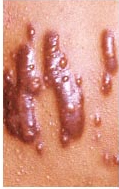|
Intermix.org.uk is a website for the benefit
of mixed-race families, individuals and anyone who feels they have a multiracial
identity and want to join us. Our mission is to offer a view of the mixed-race experience, highlighting icons, film, books, poetry, parenting techniques, celebrities, real lives and much more. Our online forums are a great place to meet others, ask questions, voice your opinions and keep in touch. Sign up for our monthly newsletter and delve into our pages. Want to join in? Become an Intermix member to take part: |
Tell Me More About Keloid Scarring
 My
son recently had a small operation which left a scar that has healed
oddly. Our doctor says it has become keloid. Can you tell me anything
more about it? Caroline
My
son recently had a small operation which left a scar that has healed
oddly. Our doctor says it has become keloid. Can you tell me anything
more about it? Caroline
A keloid is a scar that doesn't know when to stop. When the skin is injured,
cells grow back to fill in the gap. Somehow, they 'know' when the scar
tissue is even with the contour of the skin, at which point they stop
multiplying. When the cells keep on reproducing, the result can become
a keloid scar. When a scar becomes keloid it may extend beyond the site
of injury and will not subside.
People of African or Asian descent are more likely to get keloids than
people with lighter skin. (In this respect, keloids are exactly the opposite
of most skin cancers which tend to occur in light-skinned people.)
Keloids can occur anywhere on the body but are most likely to appear
on the ear lobes, neck, chest, or back, and usually occur after an injury
or surgery. Occasionally they occur spontaneously, especially on the
mid-chest area. Keloids often follow inflammation caused by acne on the
face, chest, and back.
Keloids may be painful both physically and emotionally (from a cosmetic
perspective), but it's important to address keloids primarily as a medical,
rather than cosmetic condition.
At present there are no acceptable solutions for removing
keloid scarring. Surgery is not advisable as you may end up with an even
larger keloid than you previously had.
Cryosurgery which involves freezing the keloid with liquid nitrogen may
flatten it, although this method can also produce discoloration of the
skin.
Silicone sheeting appears to minimise some keloids if used regularly
over several months. Silicone sheets are available without prescription
from most chemists.
Long-term compression of keloids with pressure bandages can help soften
them but this does require perseverance.
The most common treatment method is a series of cortisone injections
but there can be side-effects such as a 'cortisone flare,' a condition
where the injected cortisone crystallizes and can cause a brief period
of pain worse than before the shot. This usually lasts a day or two and
is best treated by icing the injected area. Another common side-effect
is whitening of the skin where the injection is given and should be of
concern to people with darker skin.
Some doctors cut the keloids out and inject the healing site with cortisone
to help prevent recurrences. Whilst others may opt to use laser surgery
which will help lessen the redness but will do nothing to the bulk of
the keloid.
If you know that you have skin that is prone to keloid scarring then
where ever possible avoid elective surgery, tatooing or body piercing.
The best advice is to learn to live with your keloid if you can. They
cannot be prevented and it is just down to luck as to whether one will
form from a scar.
Remember a scar is a permanent reminder of something that you have come
through, if you can see it as a positive experience it will be easier
to live with.
